Karipap Pusing (Malaysian Spiral Curry Puffs) are super flaky, melt-in-your-mouth delicious fried turnovers filled with a fragrant curry-infused filling of potatoes and chicken.
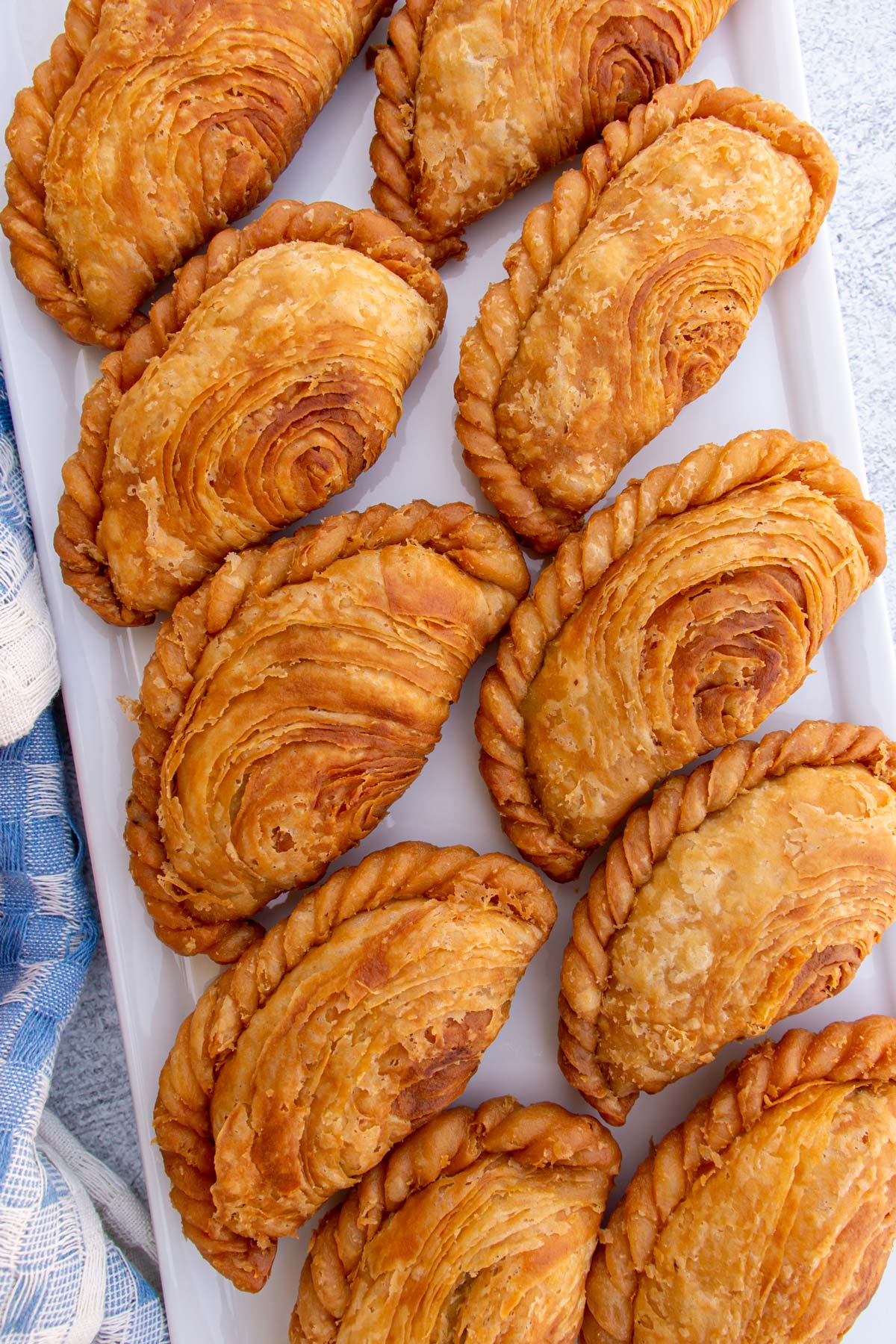
Karipap, or Curry Puff, is a small, usually deep-fried but sometimes baked half-moon shaped pastry typically filled with a thick curried chicken and potato filling.
These Malaysian curry puffs can feature a smooth dough (sometimes called epok-epok) or a spiral patterned dough (called karipap pusing 螺旋咖喱角), with the Malay word pusing referring to the spiralized pattern.
Although making a smooth dough for karipap is easier, the impressive spiral pattern is worth the additional steps to achieve. The gorgeous aesthetics aside, the flavor and texture is absolutely outstanding.
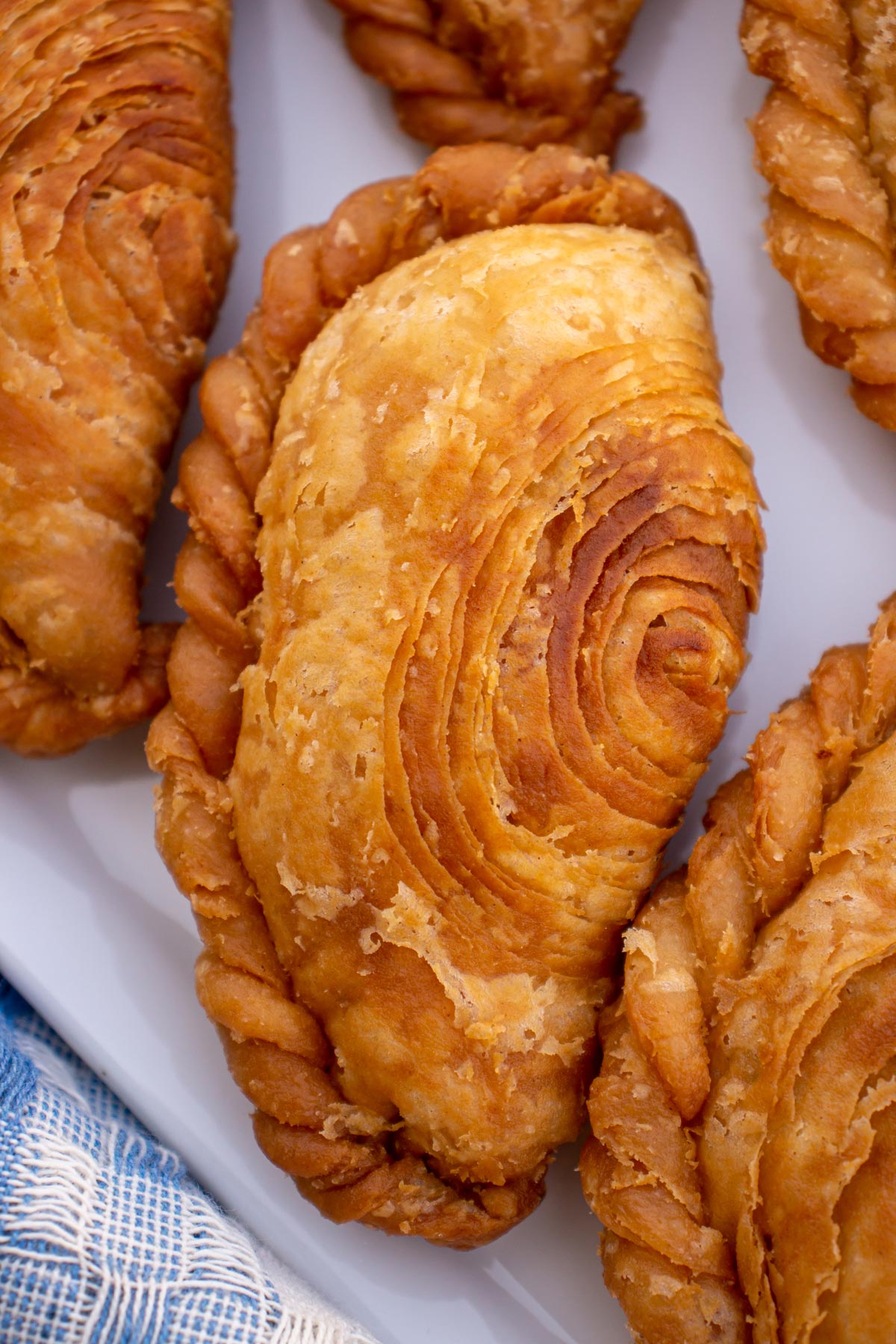
Making the signature flaky spiral pattern requires making two kinds of dough, a water dough and an oil dough, and wrapping one with the other. From this point, it’s just a matter of folding and rolling to get the desired result. It takes time, but is very simple and straightforward to do.
There are many other filling variations one could use for karipap including eggs, sardines, tuna, and various vegetables. Additionally, there are varieties of curry puffs common in other Southeast Asian countries including Indonesia, Singapore, Thailand, Myanmar, and more. The fillings and doughs can vary quite a bit.
I’ve had curry puffs from local Malaysian and Southeast Asian restaurants in New England, and many serve theirs with sweet chili sauce for dipping. It may not be traditional, but it sure is delicious!
Ingredient notes
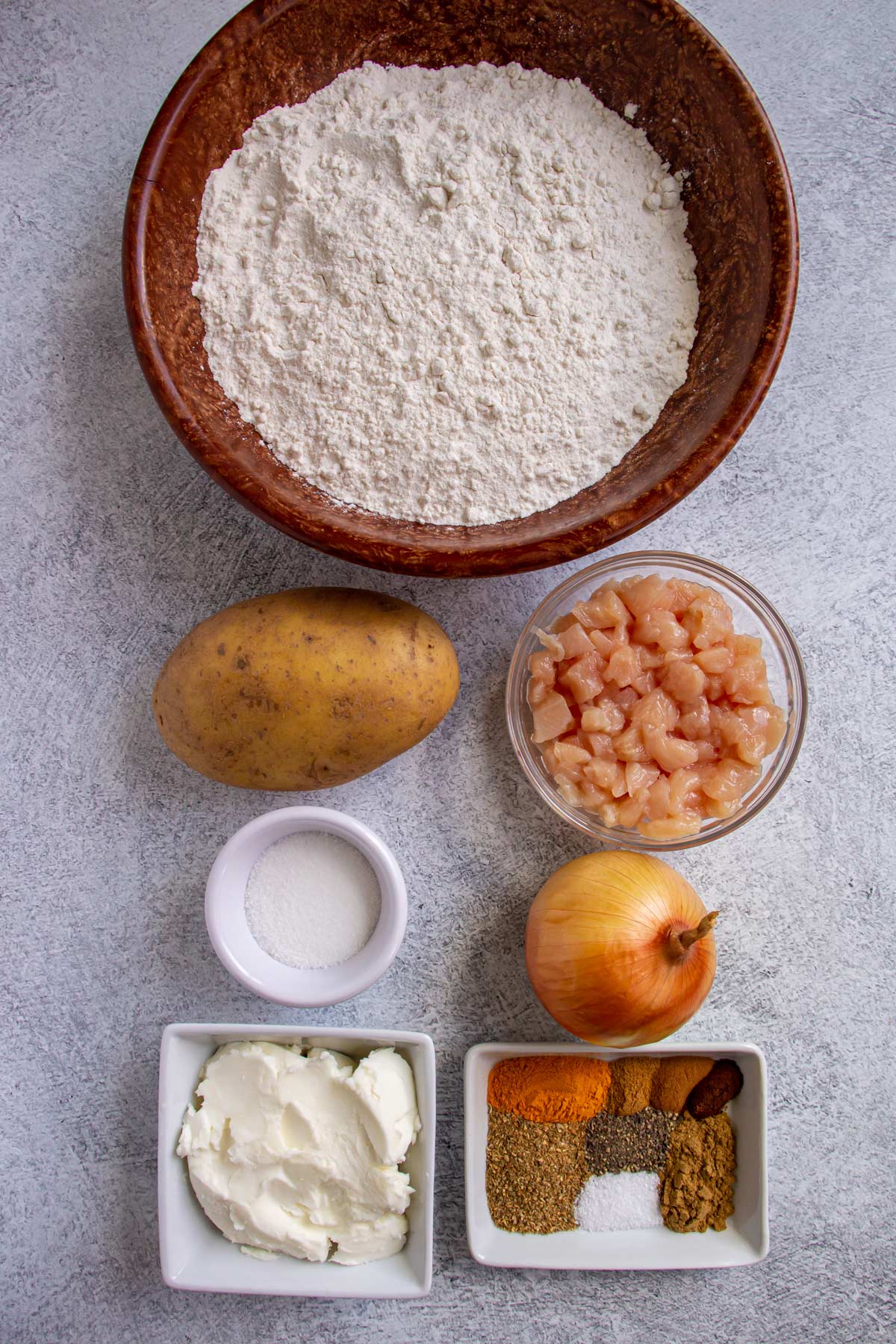
- Spices: Karipap pusing is usually flavored with Malaysian meat curry powder. To make this recipe more accessible for anyone who can't find it, I copied the spices you may find in that type of curry powder (these can vary as well). You could, however, substitute 2 ½ teaspoons of another type of prepared curry powder for the coriander, turmeric, cumin, black pepper, cayenne pepper, cinnamon, and cloves.
- Shortening: You can use vegetable shortening or lard to make the dough. Many brands of vegetable shortening are hydrogenated (which is really bad for you). If you can, I recommend using non-hydrogenated vegetable shortening for this and any recipe calling for shortening.
- Potato: The main ingredient in the filling is potato. I use gold or yellow potatoes here, which are a waxy type of potato, good at holding their shape after cooking. Peel and dice the potato fairly small, into about ¼-inch pieces.
- Chicken: The chicken is not the star of the filling, but it adds a bit of protein along with another flavor and textural element. Dice chicken breast to a similar size as the potato, about ¼-inch pieces. If you wanted to make these karipap pusing vegetarian, you could replace the chicken with fresh or frozen peas (add them toward the end of the potato cooking time), and use vegetable shortening instead of lard in the dough.
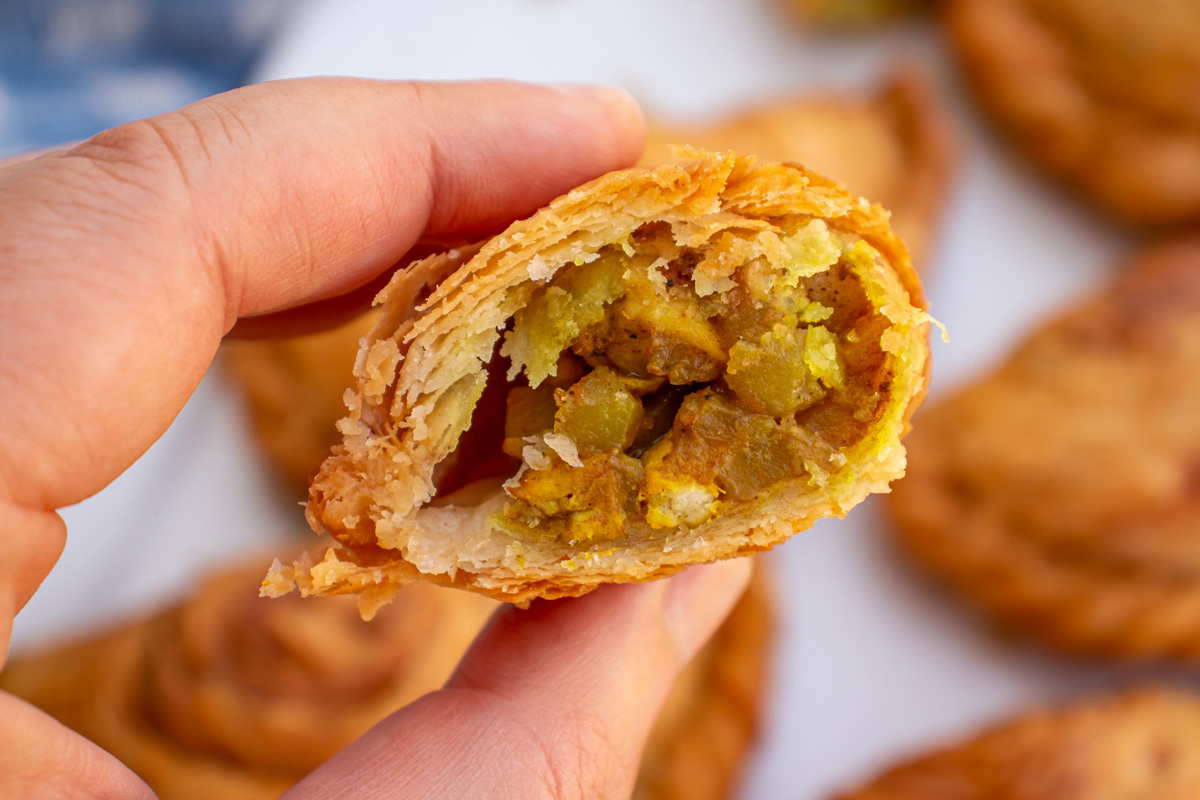
How to make the filling
Heat oil in a skillet or wok over medium heat. Add finely chopped onion and cook until softened (PHOTO 1). Then add diced chicken and continue stirring and cooking for a couple minutes (PHOTO 2).
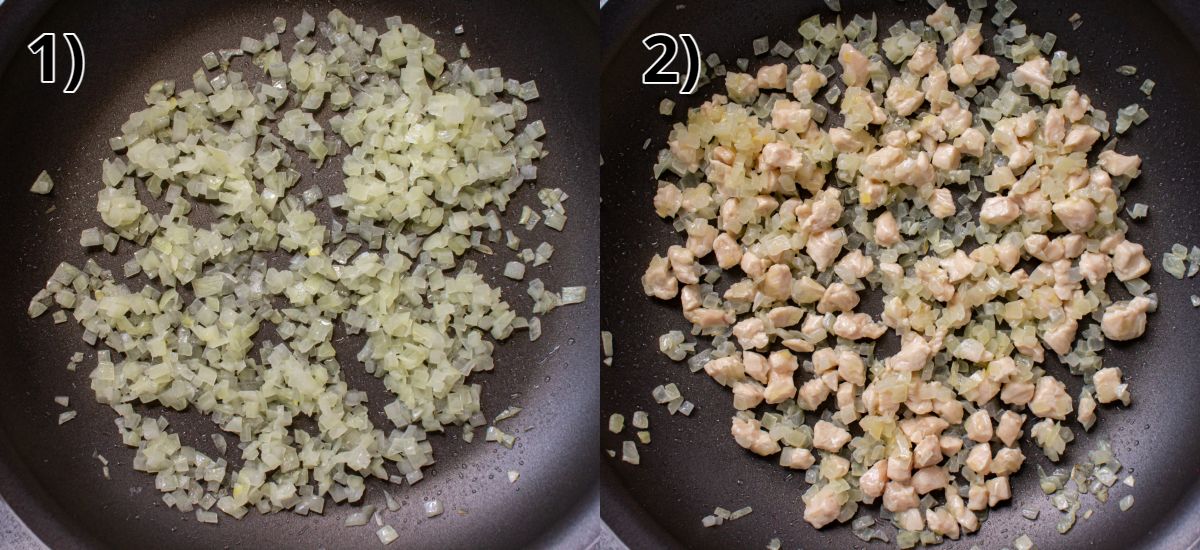
Add finely diced potato and seasonings (PHOTO 3), stir to coat, then add water and cover with a lid. Cook until the potato is tender and there is little liquid remaining (PHOTO 4).
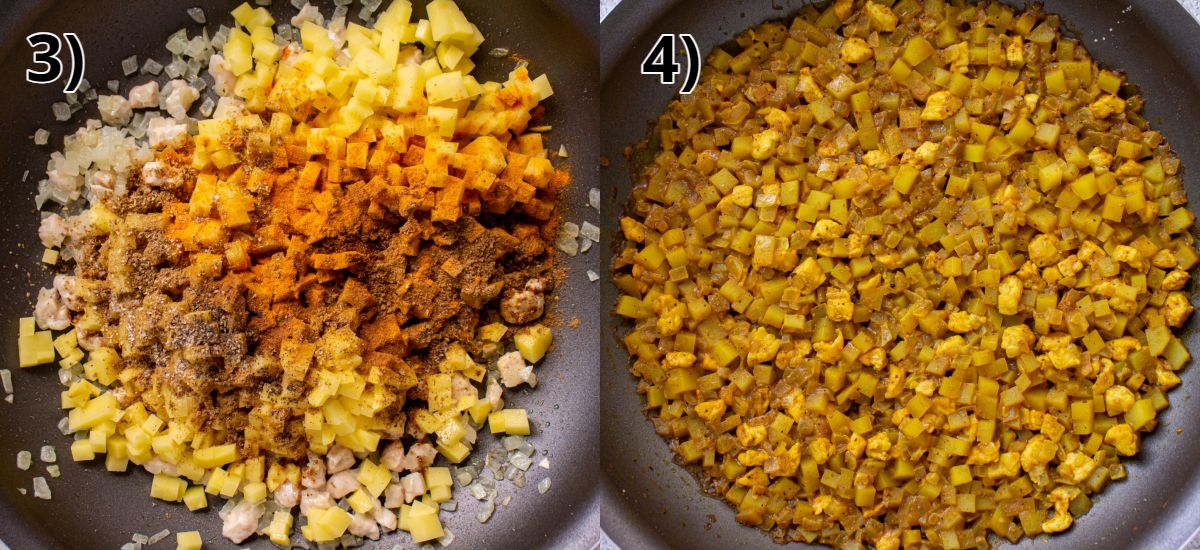
Remove from the heat and slightly mash some of the potato with the back of a spoon to make the mixture more cohesive. Transfer to a bowl and cool completely before using. The karipap pusing filling can be prepared up to 2 days in advance, covered in plastic wrap, and refrigerated. Return to room temperature before using.
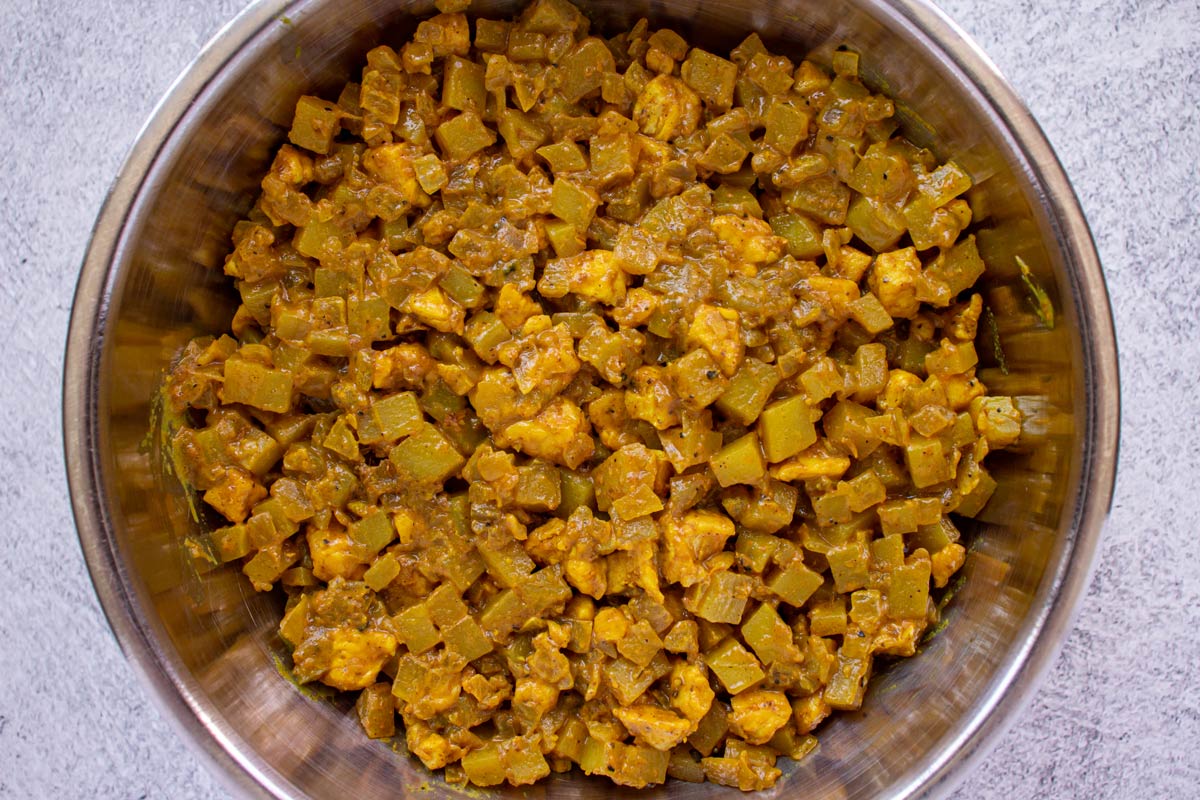
How to make the dough
First make the water dough. Combine flour, sugar, and salt in a mixing bowl. Add shortening or lard and rub it into the flour mixture to combine and create a crumbly mixture (PHOTOS 5-6).
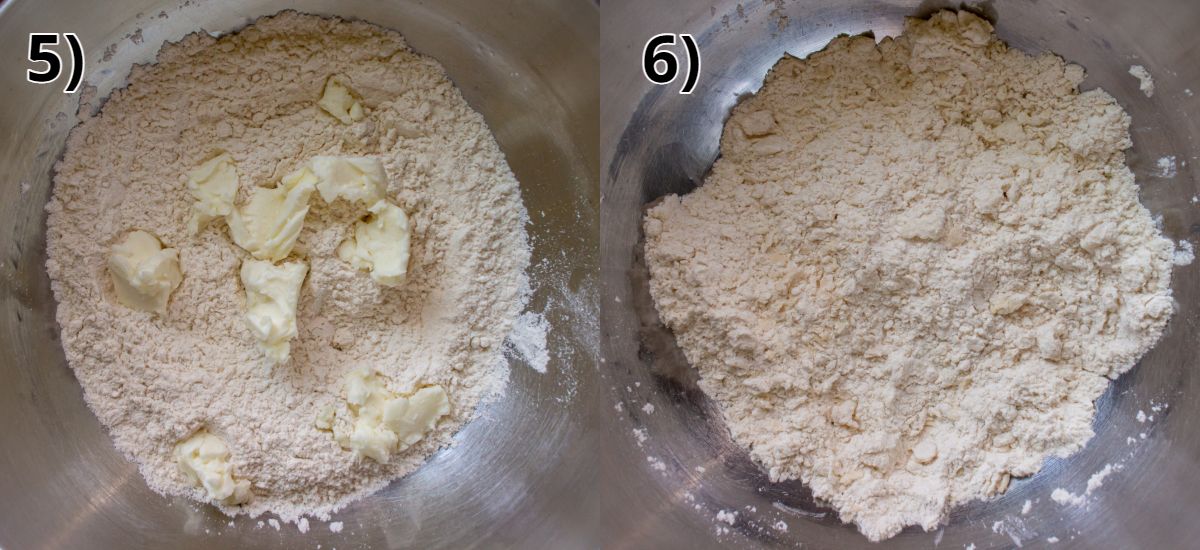
Add water and combine, bringing the dough together, and kneading gently, to yield a soft, smooth dough.
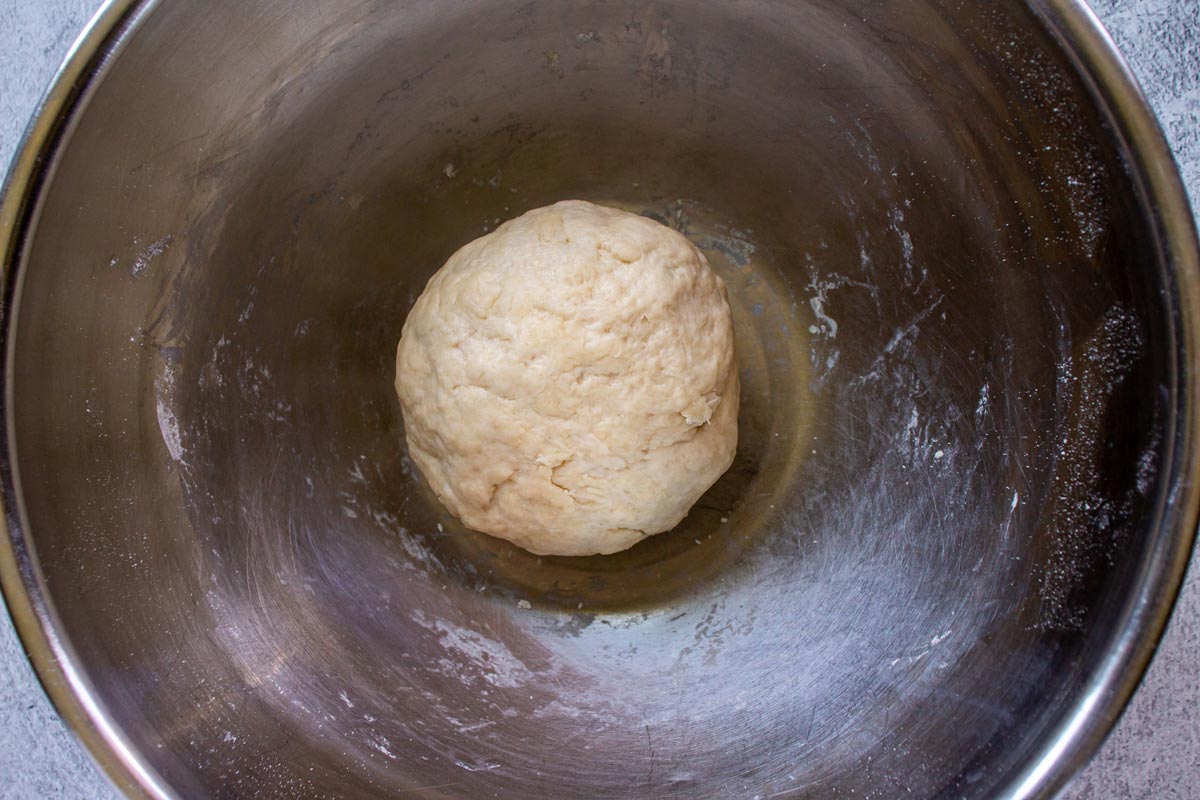
Wrap it in plastic wrap and set aside at room temperature for 30 minutes.
Next make the oil dough. Combine flour and shortening or lard in the same bowl used to make the water dough (PHOTO 7). Knead it until it becomes a smooth and pliable dough. It will resemble soft cookie dough. Form roughly into a ball, cover and set aside until the water dough is done resting (PHOTO 8).
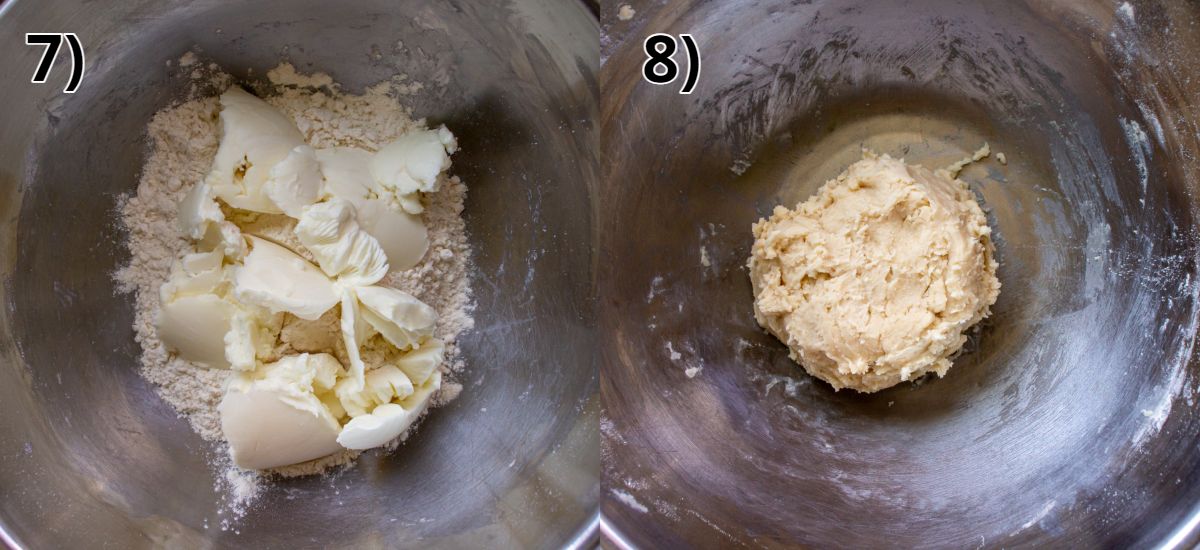
Finally, laminate the dough. Place the water dough on a very minimally floured work surface. Roll it out into a 7 ½-inch diameter circle.
Place the oil dough into the center of the circle (PHOTO 9). Pull up the sides of the water dough to completely enclose the oil dough and pinch the ends together to seal it closed (PHOTO 10). Let it rest for about 10 minutes before rolling out.
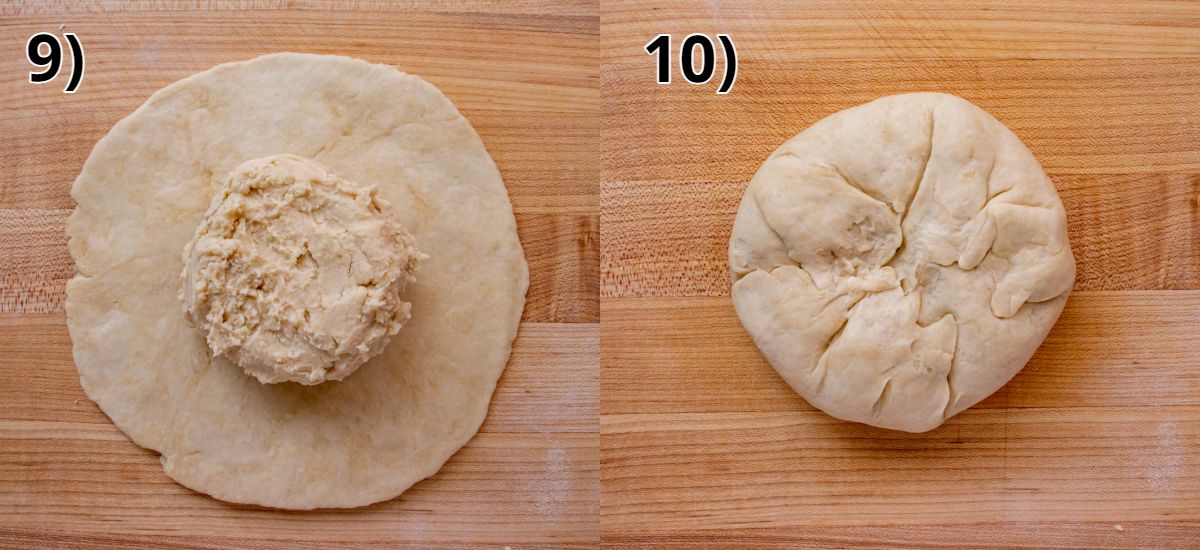
Use a rolling pin to roll the enclosed dough on a lightly dusted surface. Roll it into a rectangle about 8-by-12-inches with the long side closest to you.
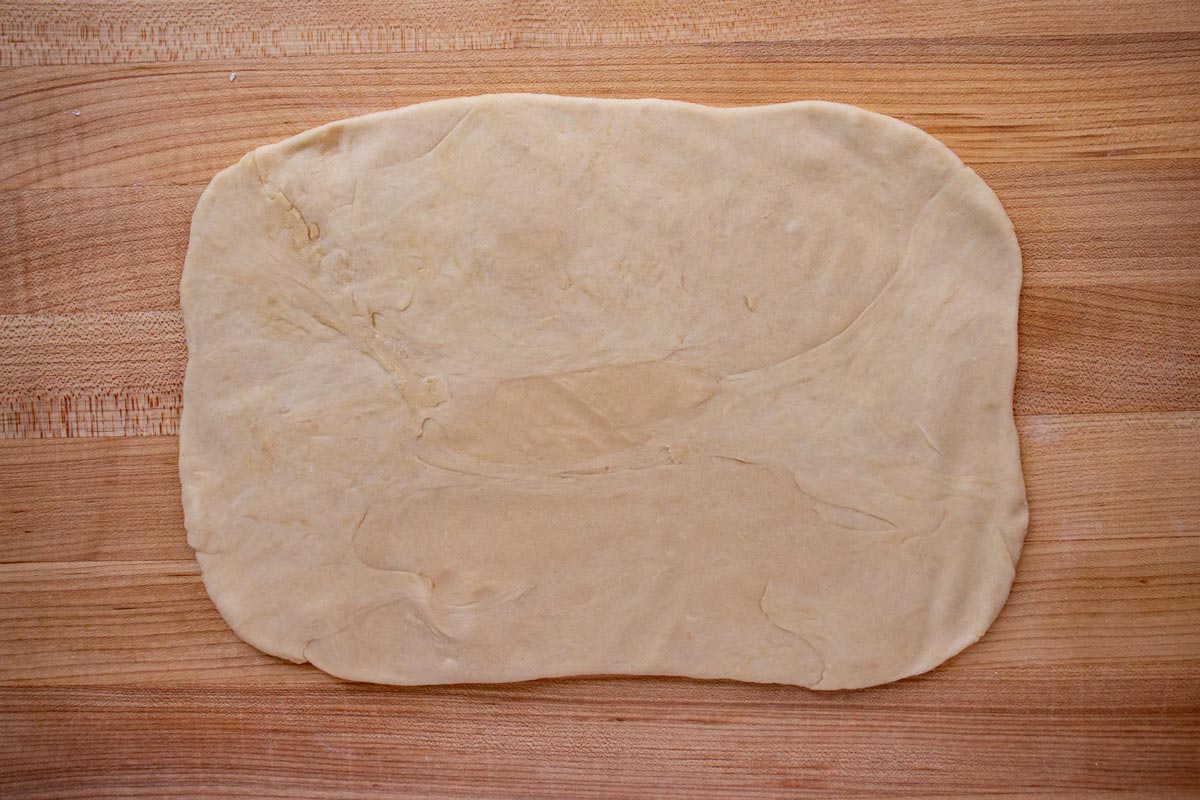
Fold the dough into thirds like a letter, resulting in a rectangle about 8-by-4-inches.
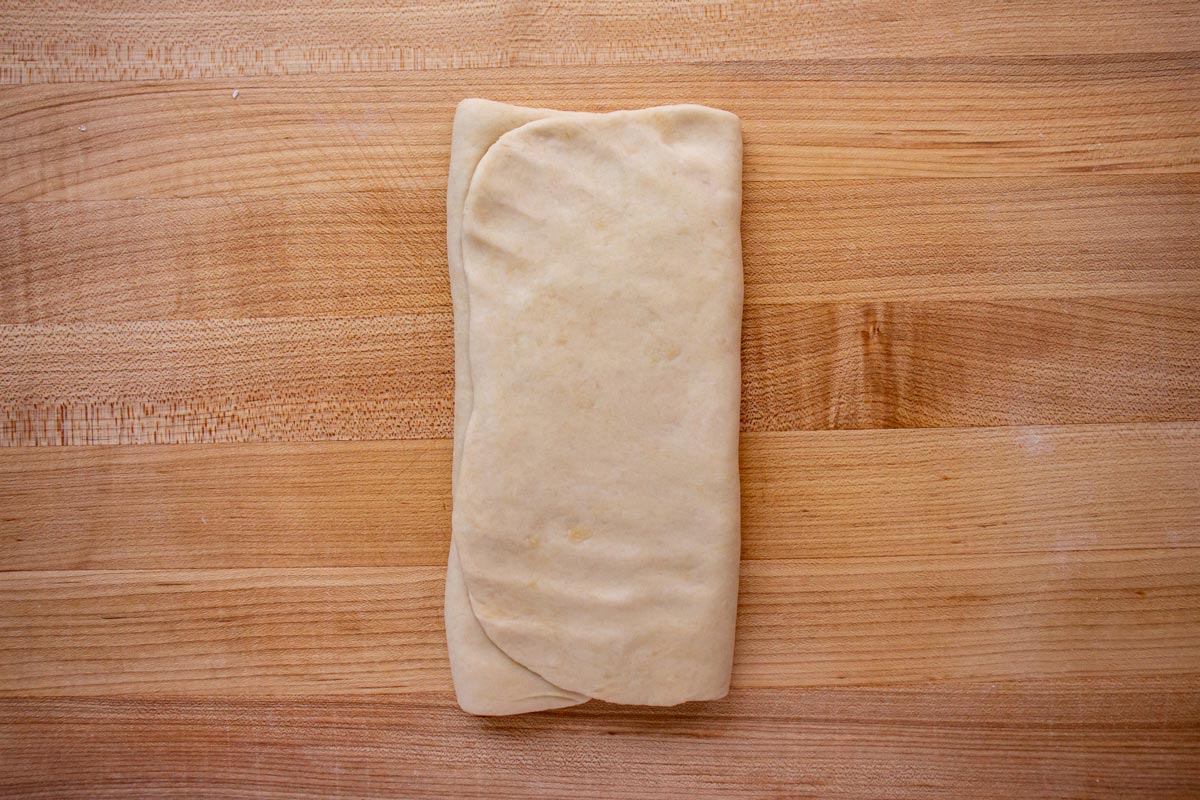
Rotate the dough 90 degrees so one of the folded sides is closest to you.
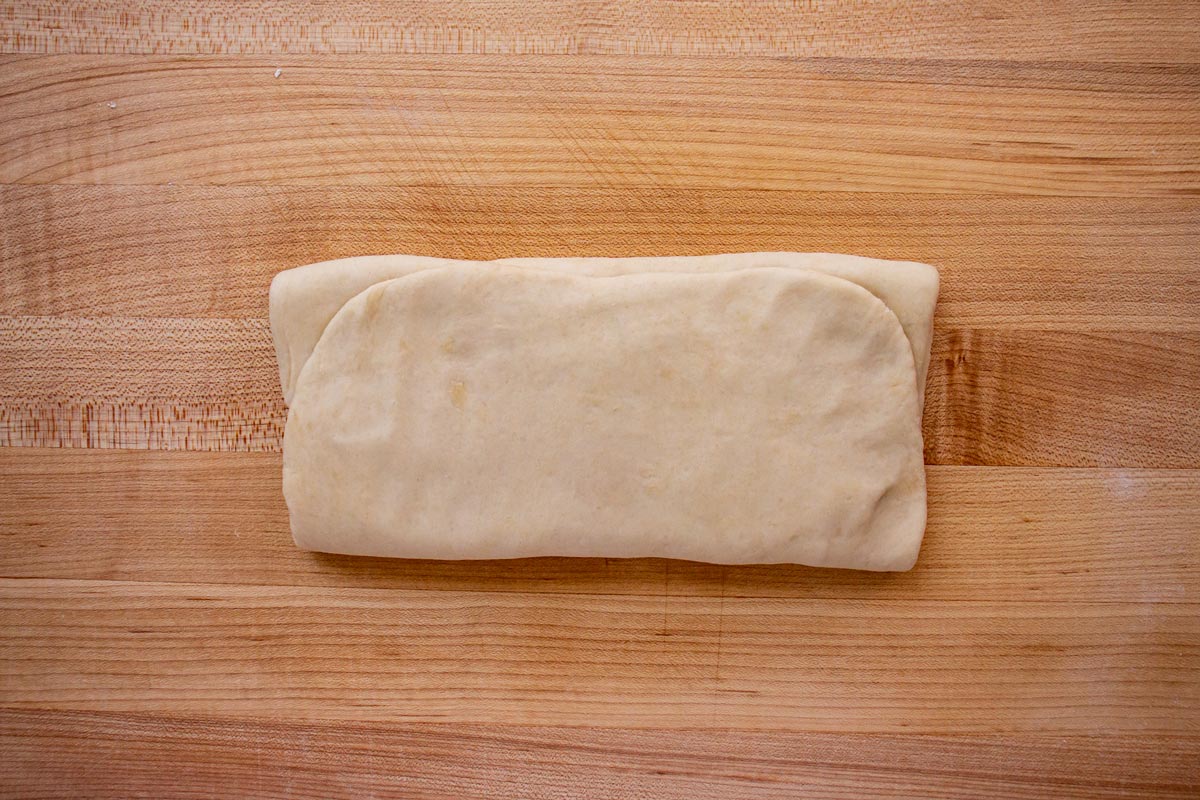
Then roll it out again into an 8-by-12-inch rectangle.
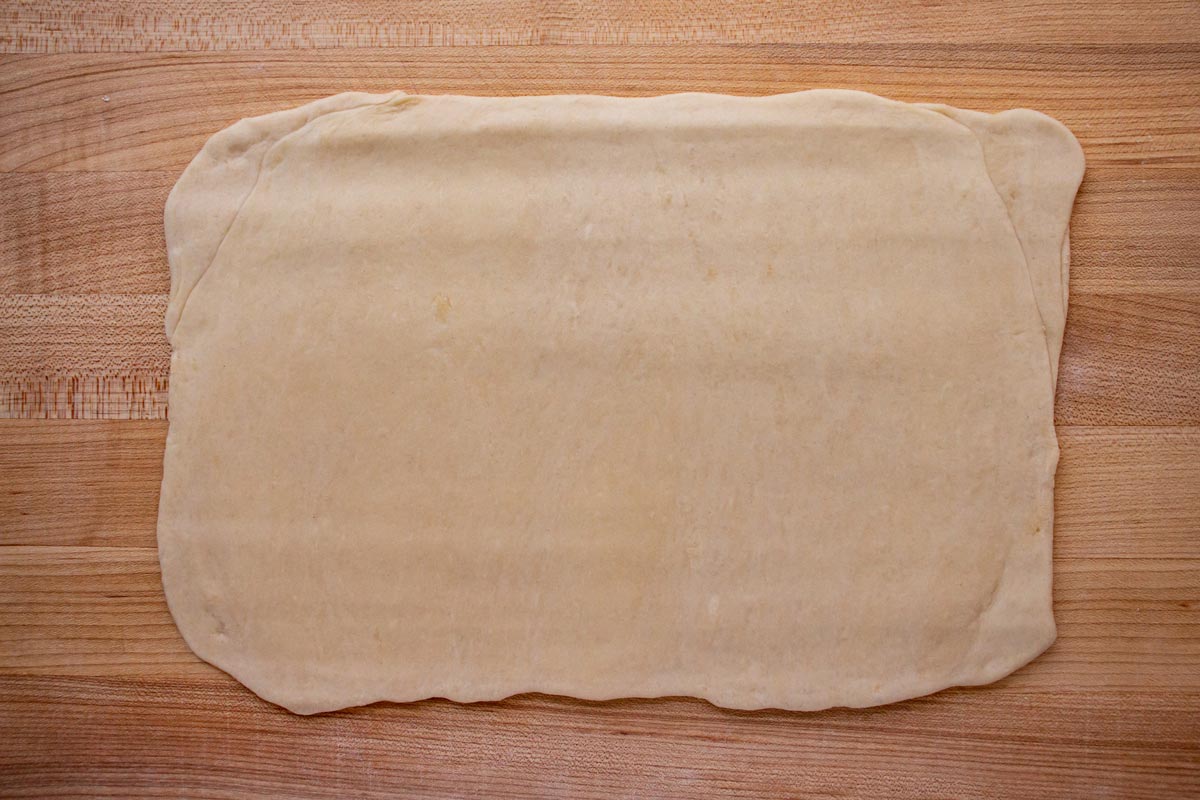
Fold it again like a letter into thirds into an 8-by-4-inch rectangle.
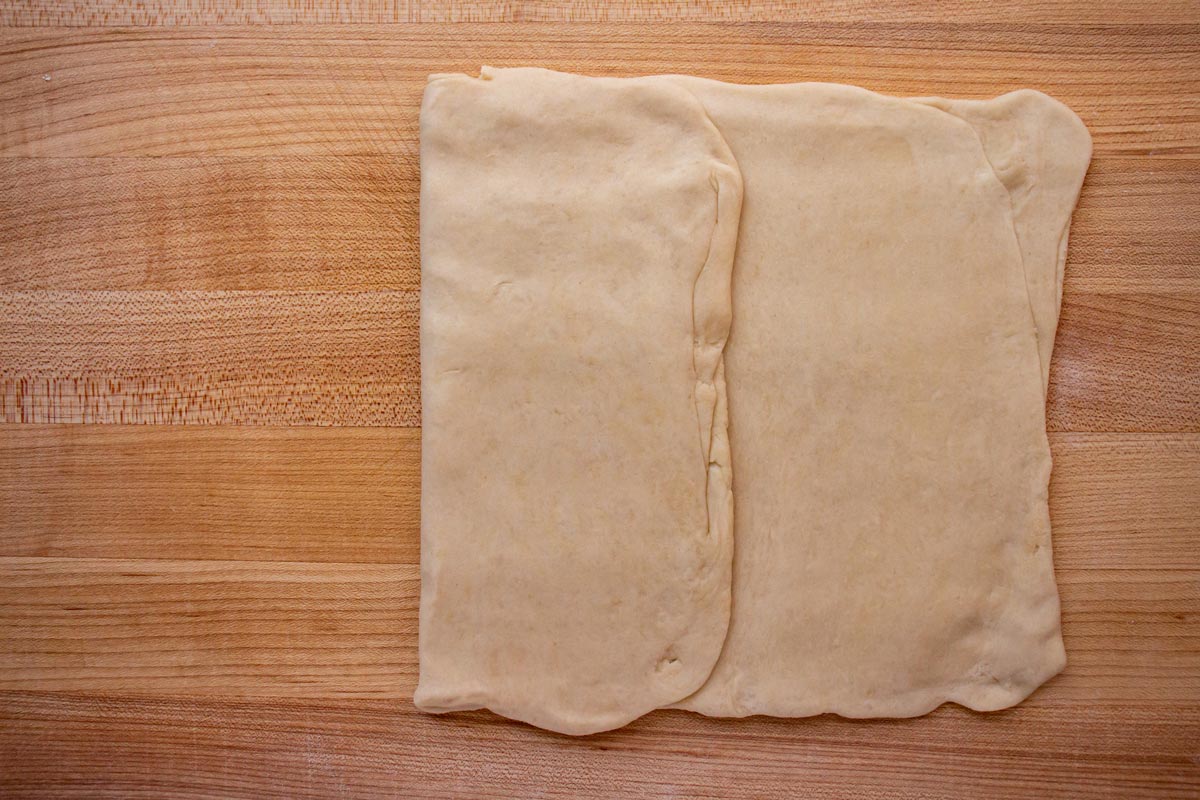
Wrap or cover the dough, and let it rest for 15 minutes.
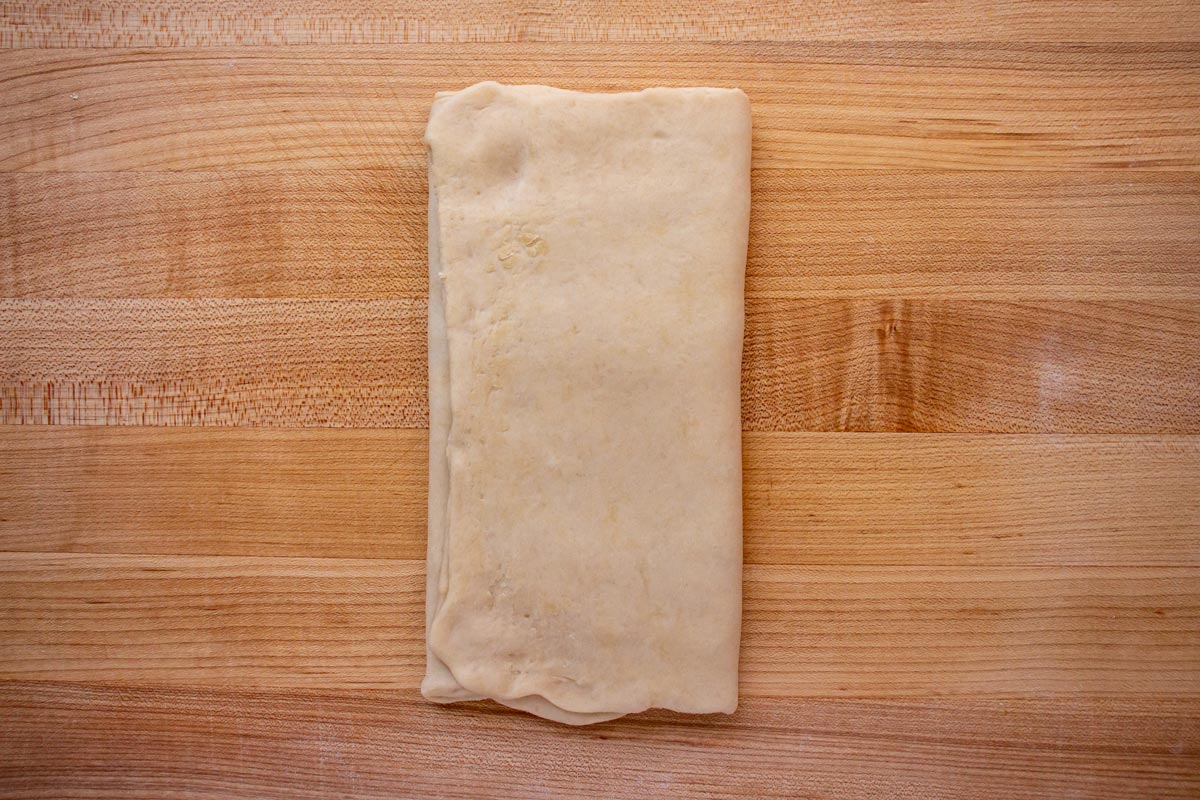
How to assemble the curry puffs
On a lightly floured surface, rotate the dough another 90 degrees, and roll it out into a rectangle measuring 8-by-12-inches, with the long edge closest to you.
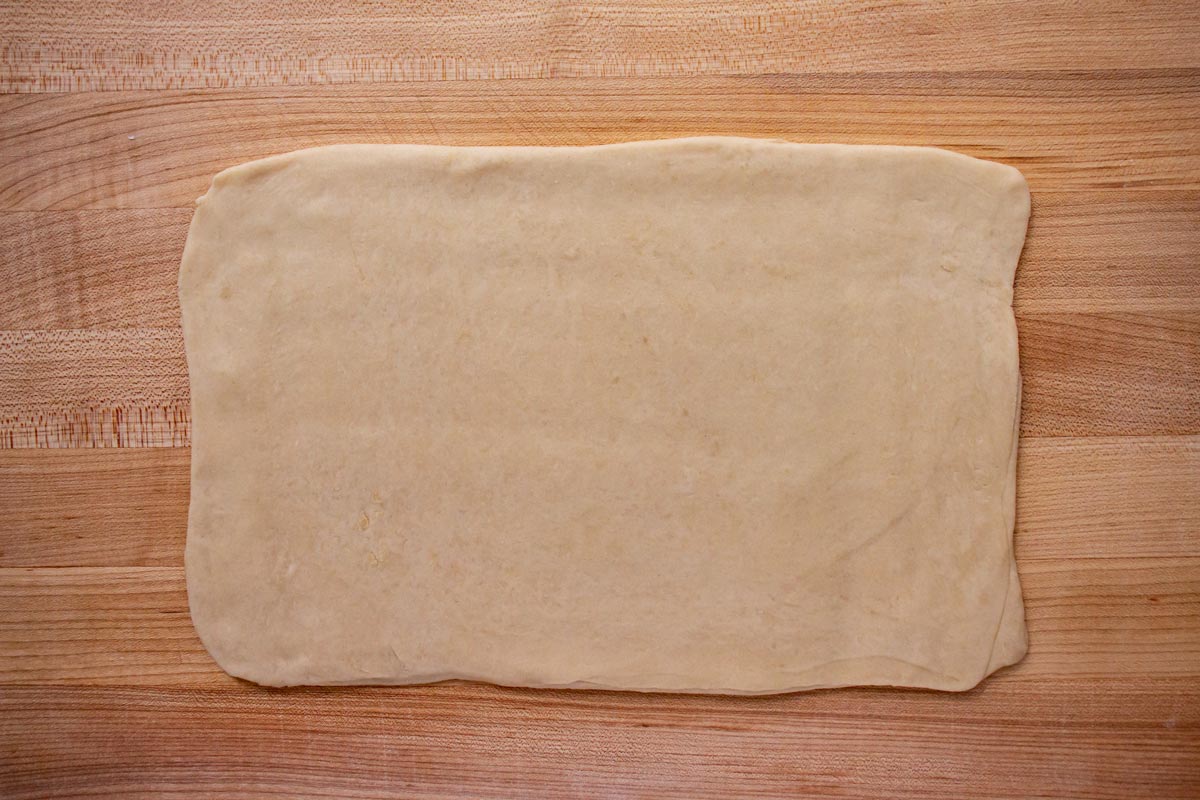
With your fingers, roll the karipap dough into a long cylinder (like a jelly roll) starting with the edge closed to you and rolling away from you.
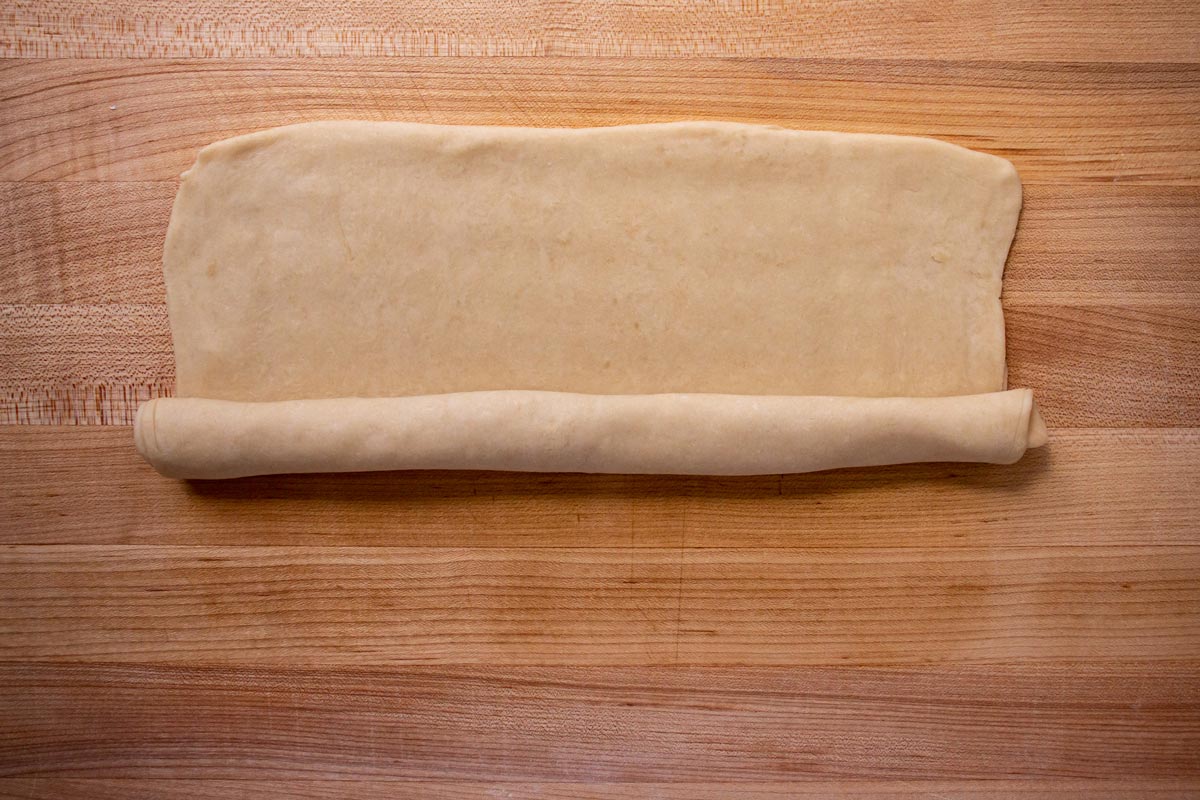
Cut the dough crosswise into 12 slices. Keep the dough covered and work with half the slices at a time.
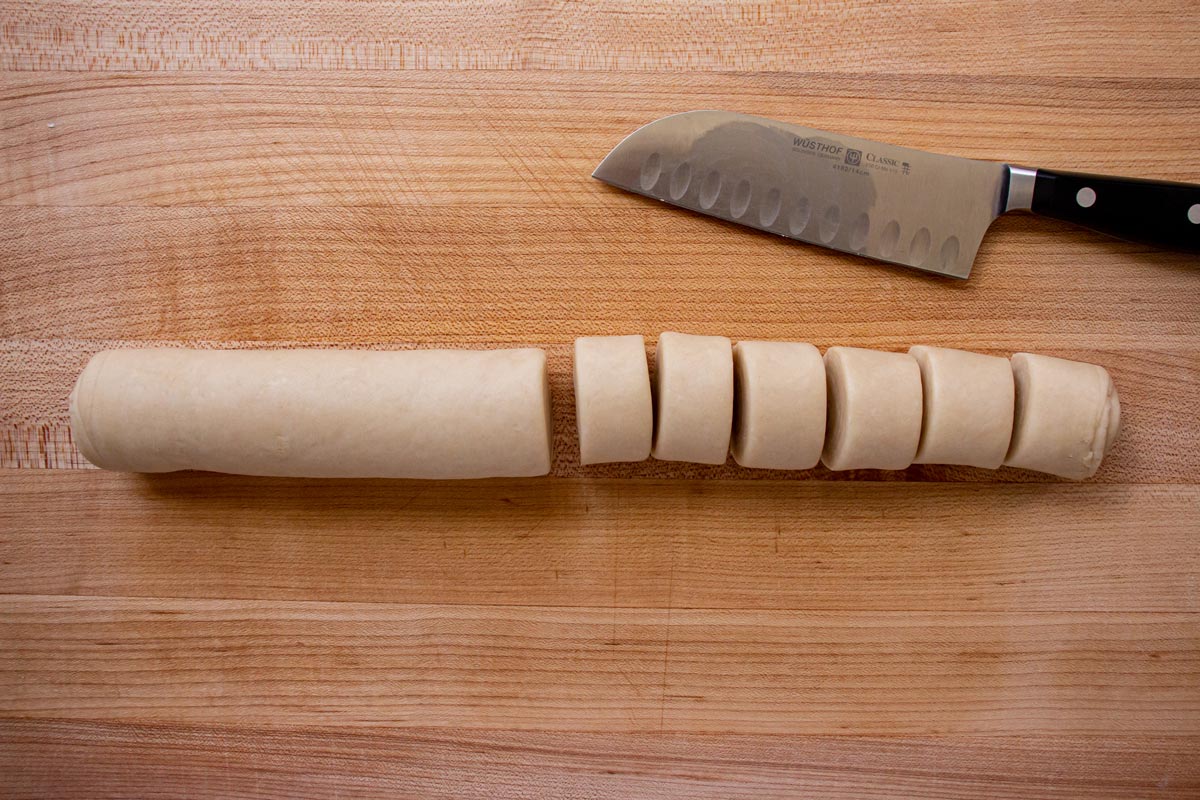
On a lightly floured surface, use the heel of your hand to flatten each dough piece into a disk.
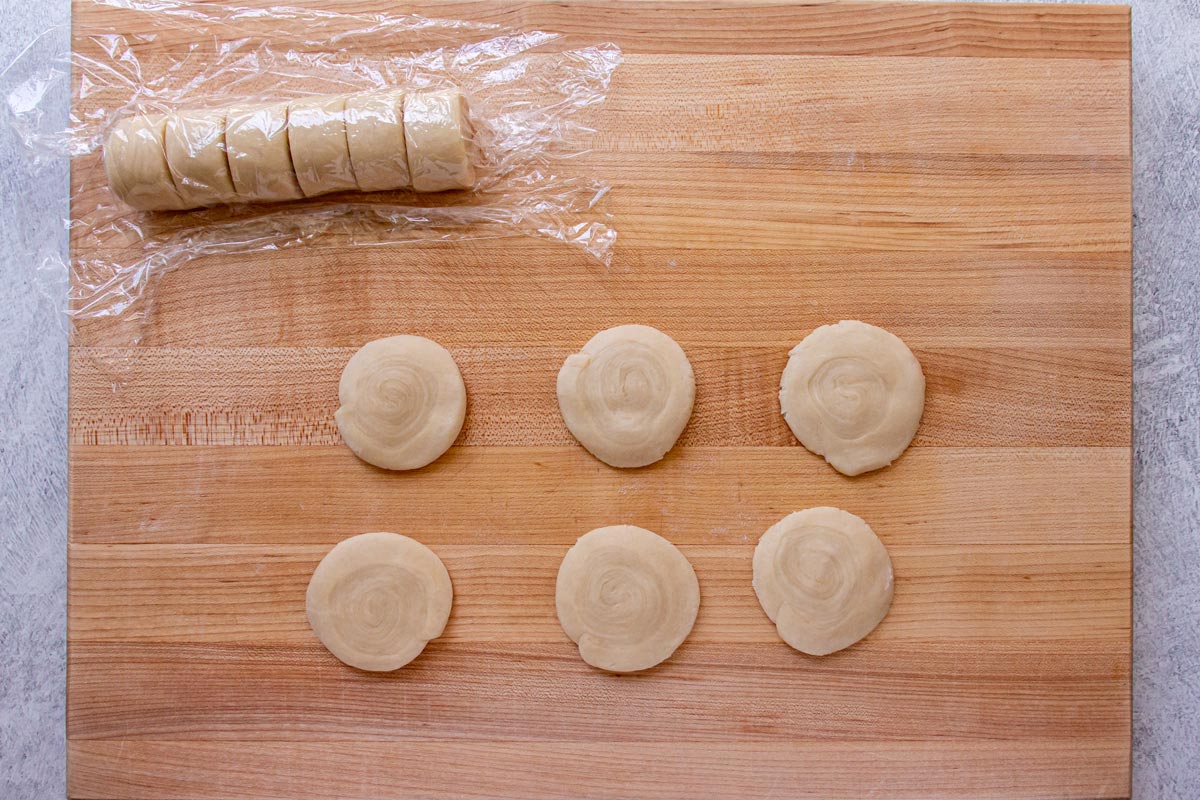
Use a rolling pin (preferably a skinny Asian dowel-style rolling pin) to roll each disk into a thin circle, about 4 ½-inches in diameter.
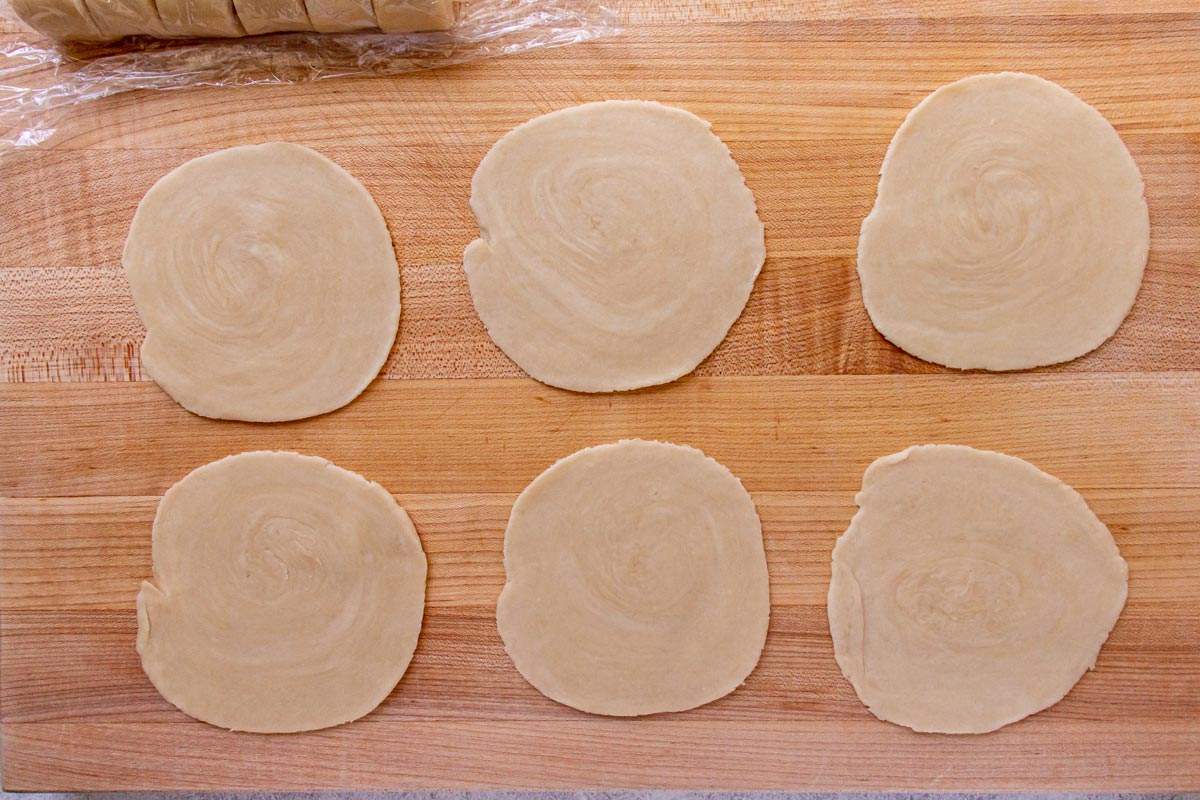
Place one portion (or one-twelfth) of the filling into the center of each circle.
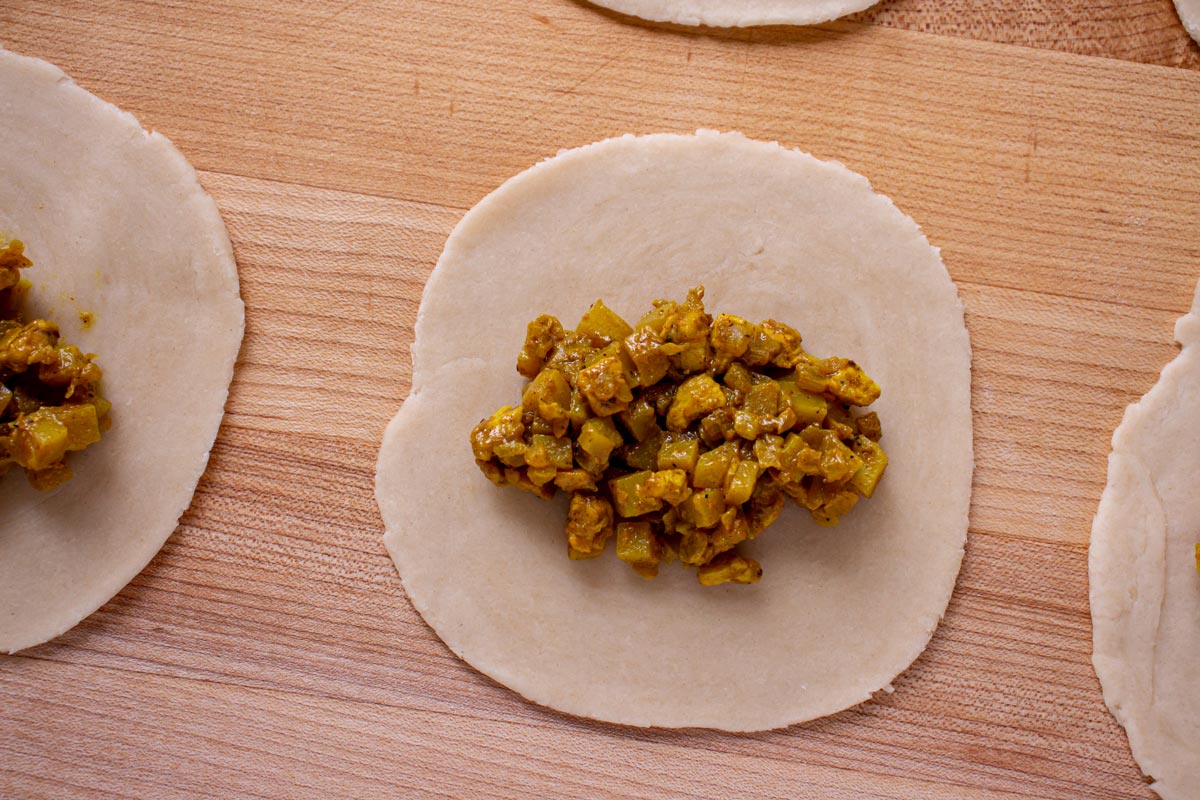
Lightly wet the edges with a little water on your fingertip. Fold the dough over itself to create a half-moon and press the edges together to seal.
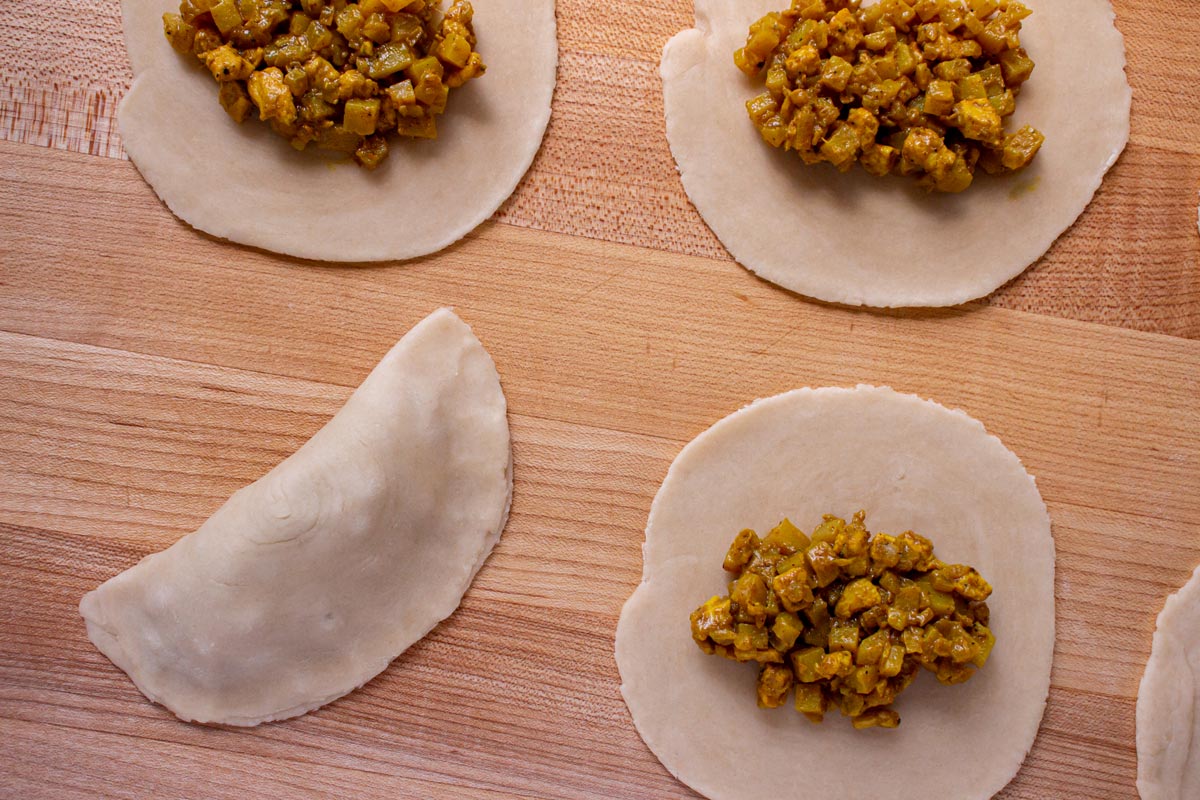
Pleat along the sealed edge to create a rope-like pattern from one end to the other (pinch and fold over onto itself). Set aside on a parchment paper covered baking sheet, cover, and repeat with the remaining dough and filling.
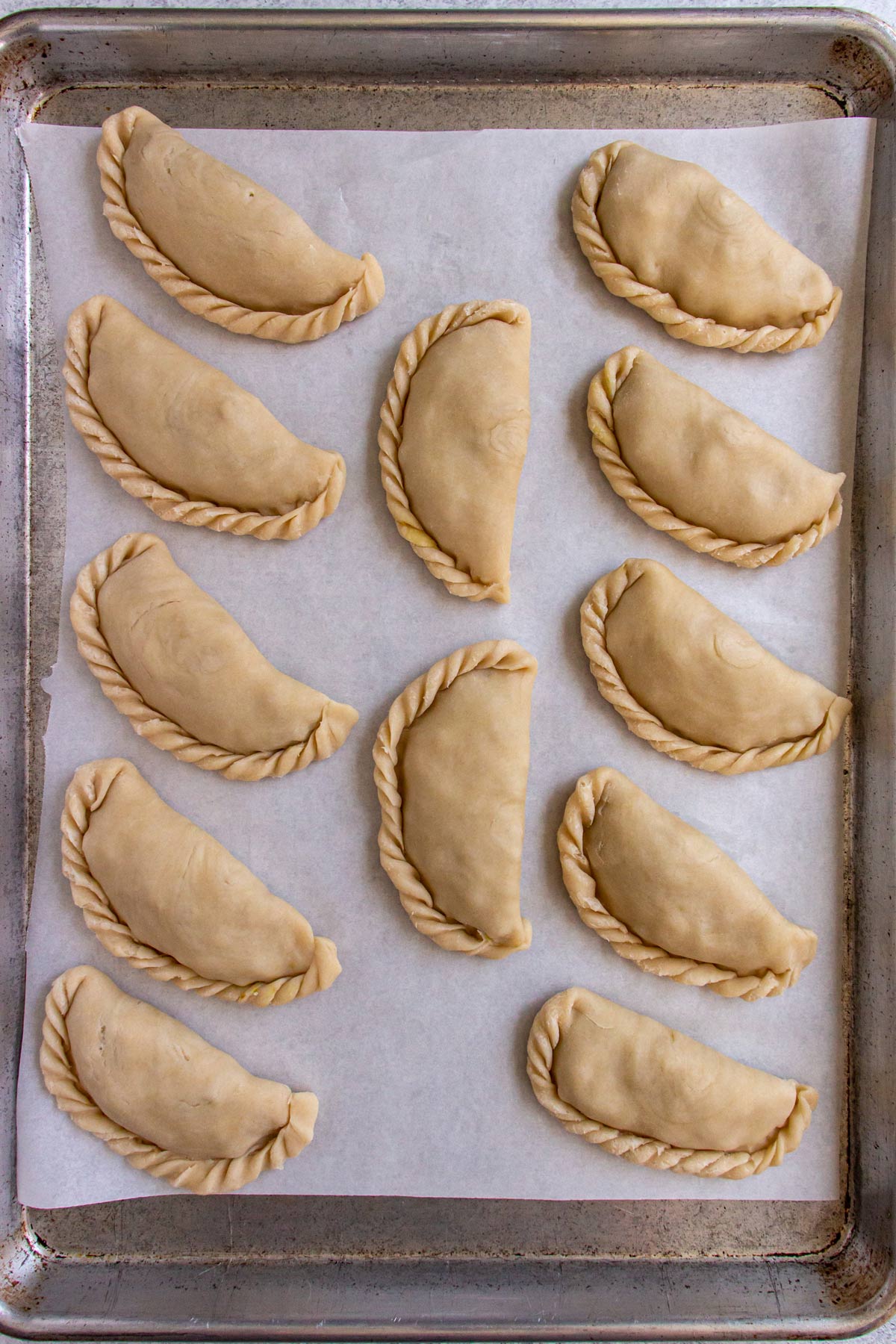
How to cook them
Place a rack on top of a paper towel-lined sheet pan for draining the finished karipap pusing.
Heat oil in a Dutch oven, wok, or deep saucepan, or deep-fryer at a depth of about 1 to 2 inches to 375°F. Add curry puffs in small batches and fry until golden brown, about 5 minutes, gently jostling them around a bit with a spider skimmer to keep the bottoms from over-browning, and occasionally flipping them over so they cook evenly (PHOTOS 11-12).
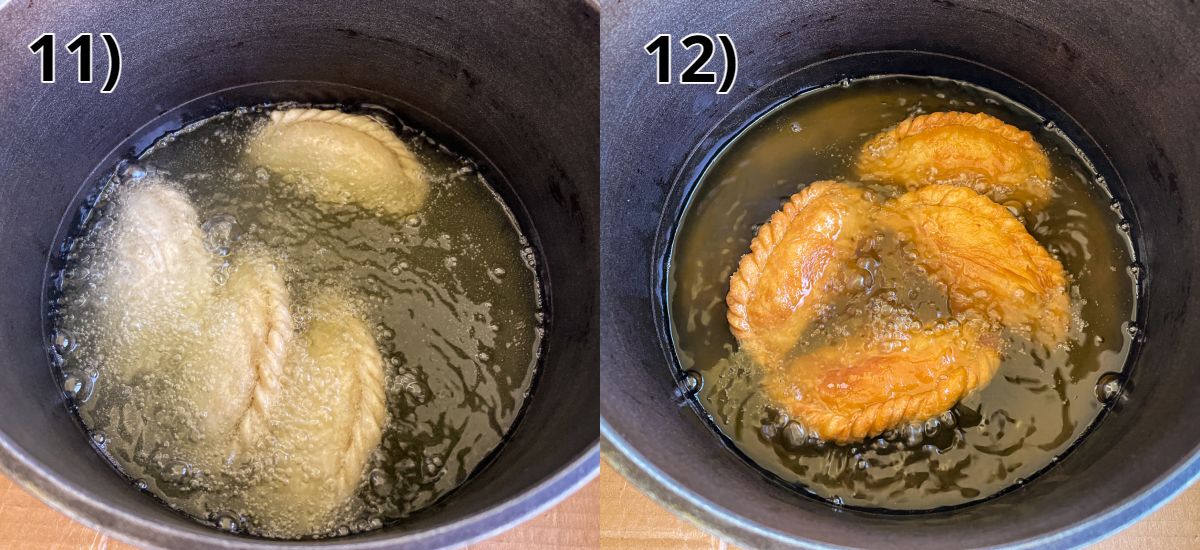
Use a spider skimmer to remove finished karipap from the oil and let them drain and rest on the prepared rack. Repeat with additional karipap pusing until they are all fried.
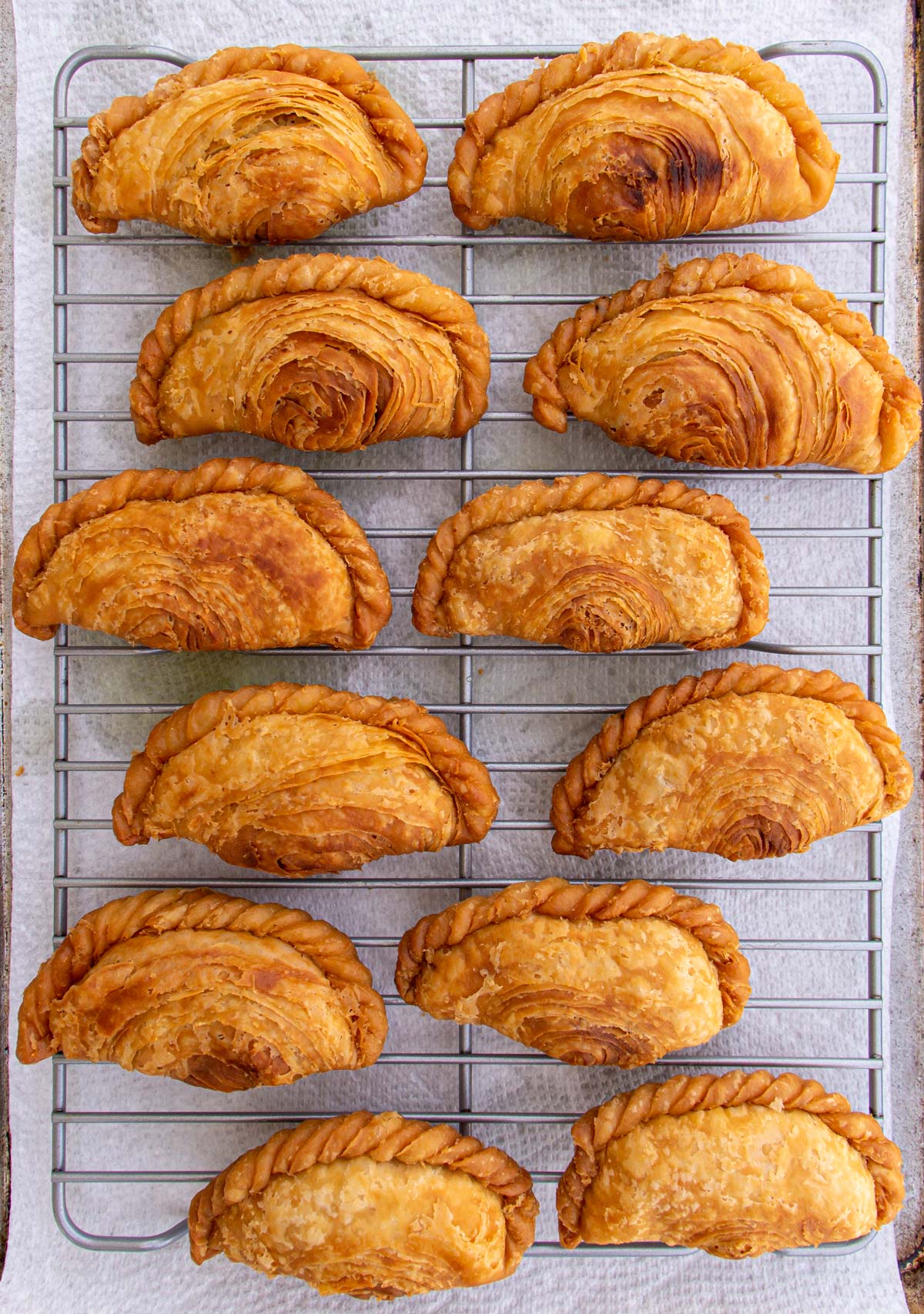
You may keep the curry puffs warm in a 200°F oven if you’d like, but they will stay crispy for a while at room temperature.
Serve hot, warm, or at room temperature. Optionally, serve with sweet chili sauce on the side.
Please scroll to the bottom of the post for the full recipe (in a printable recipe card) including ingredient amounts and detailed instructions.

Expert tips
Store leftover karipap pusing in an airtight container in the refrigerator for up to 5 days or freeze for up to 1 month. Reheat leftover refrigerated karipap in an oven, toaster oven, or air-fryer at 350°F for about 10 minutes to freshen them back up.
To freeze uncooked curry puffs, place them in a single layer on a parchment paper-lined baking sheet. Freeze for 1 hour and then transfer to a freezer bag or other freezer-safe container. To cook, don’t thaw but rather fry from a frozen state using the original cooking instructions but adding a couple more minutes as needed to cook them all the way through.
To freeze cooked curry puffs, follow the same method as above to freeze in a single layer for 1 hour, and then transfer to a freezer bag or other freezer-safe container. Reheat frozen karipap pusing in an oven, toaster oven, or air-fryer at 350°F for about 10 to 15 minutes, or until heated through and crispy.
You may fry using a deep fry thermometer to track the oil's temperature. The downside to this is you may have to fiddle with your stovetop controls to adjust the heat in order to maintain the right temperature if it drops or rises significantly.
Instead, I recommend using an electric deep-fryer (I have an old version of this one passed down from my grandmother!). It does a great job of maintaining the oil temperature without any stress. I actually remove the fryer basket because it takes up room and would require me to use even more oil to get the depth I need. Instead I fry directly in my fryer and use a spider skimmer to remove the cooked karipap.
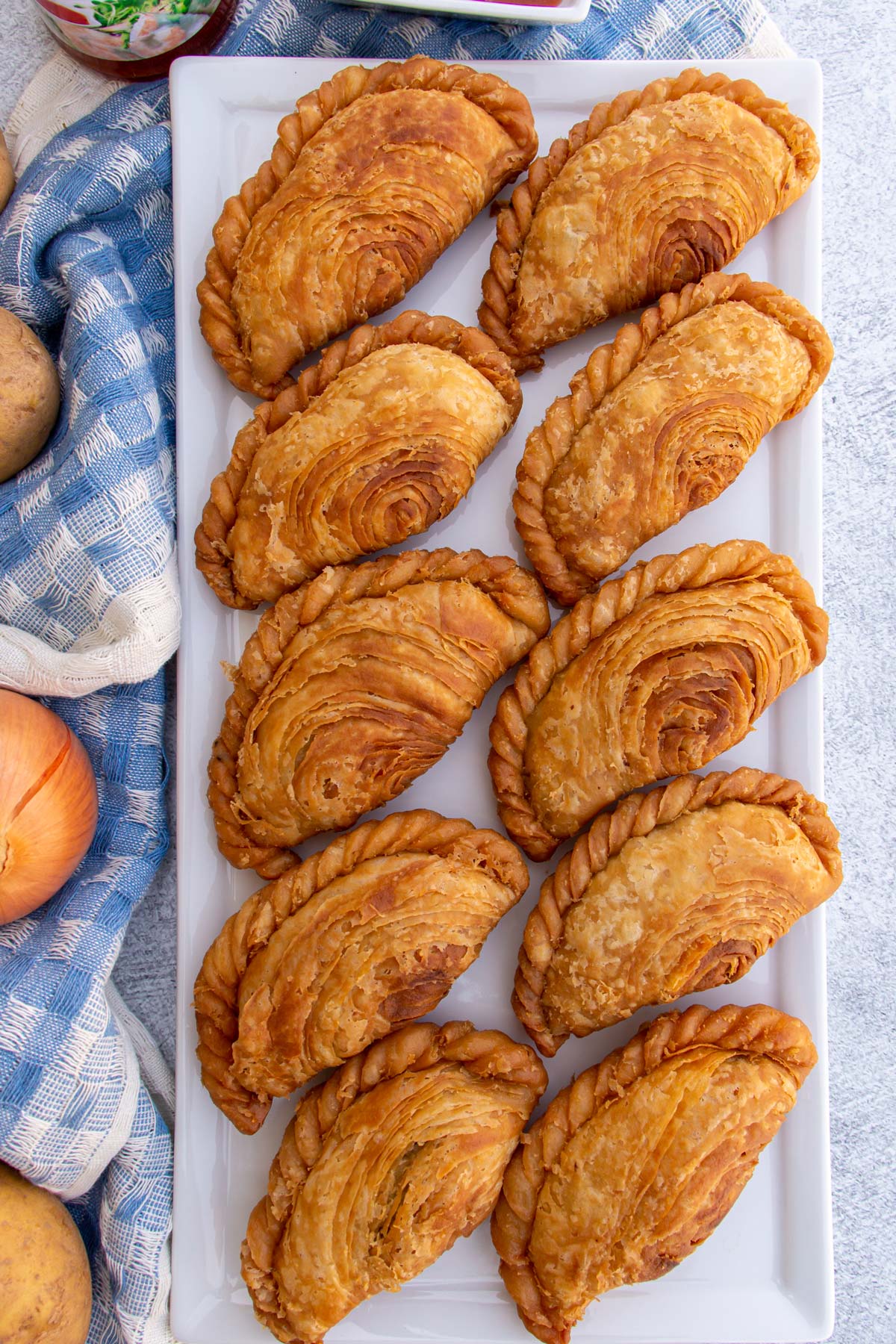
Other recipes you may like
- Char Siu Sou (Chinese Roast Pork Pastry Puffs)
- Shrimp Toast
- Chinese Scallion Pancakes (Cong You Bing)
- Homemade Pork and Vegetable Egg Rolls
- Jamaican Beef Patties
- Bitterballen (Dutch Fried Meatballs)
Tried this recipe? Please leave a star ⭐️⭐️⭐️⭐️⭐️ rating in the recipe card below and/or a review in the comments section further down the page. You can also follow me on social media on Facebook, Instagram, and Pinterest!
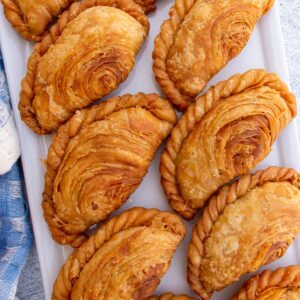
Karipap Pusing (Malaysian Spiral Curry Puffs)
Ingredients
Chicken and Potato Filling:
- 1 tablespoon vegetable or canola oil
- 85 grams (½ cup / 3 ounces) finely chopped onion (1 small onion)
- 85 grams (½ cup / 3 ounces) finely diced chicken breast meat
- 170 grams (1 cup / 6 ounces) peeled and finely diced potato
- 1 teaspoon ground coriander
- ½ to 1 teaspoon kosher salt or more to taste (start with less and add more as needed)
- ½ teaspoon ground turmeric
- ½ teaspoon ground cumin
- ¼ teaspoon ground black pepper
- ⅛ teaspoon ground cayenne pepper
- ⅛ teaspoon ground cinnamon
- ⅛ teaspoon ground cloves
- Pinch sugar (optional)
- 6 tablespoons water
Water Dough (Outer Dough):
- 150 grams (1 ¼ cups minus 1 tablespoon) all-purpose flour
- 1 ½ teaspoons granulated sugar
- ¼ teaspoon kosher salt
- 30 grams (2 ½ tablespoons) vegetable shortening or lard at room temperature
- 5 tablespoons water
Oil Dough (Inner Dough):
- 100 grams (¾ cup plus 1 tablespoon) all-purpose flour
- 85 grams (7 tablespoons) vegetable shortening or lard at room temperature
Fry and Serve:
- Vegetable or canola oil as needed for frying
- Sweet chili sauce to serve (optional)
Instructions
Filling:
- Heat the oil in a skillet or wok over medium heat. Add the onion and cook until softened, about 3 to 4 minutes. Add the chicken and continue stirring and cooking for another 2 minutes. Add the potato and seasonings, stir to coat, then add the water and cover with a lid. Cook for about 6 to 8 minutes, or until the potato is tender and there is little liquid remaining. If there is a lot of liquid, continue to cook uncovered and allow most of it to evaporate.
- Remove from the heat and slightly mash some of the potato with the back of a spoon to make the mixture more cohesive. Taste and adjust seasonings as needed. Transfer to a bowl and cool completely before using. The filling can be prepared up to 2 days in advance, covered in plastic wrap, and refrigerated. Return to room temperature before using.
Water Dough:
- Combine the flour, sugar, and salt in a mixing bowl. Add the shortening or lard and rub it into the flour mixture to combine and create a crumbly mixture. Add the water and combine, bringing the dough together, and kneading gently, to yield a soft, smooth dough. Wrap it in plastic wrap and set aside at room temperature for 30 minutes.
Oil Dough:
- Combine the flour and shortening or lard in the same bowl used to make the water dough. Knead it until it becomes a smooth and pliable dough. It will resemble soft cookie dough. Form roughly into a ball, cover and set aside until the water dough is done resting.
Laminate the Dough:
- Place the water dough on a very minimally floured work surface (use as little flour as you can to keep it from sticking but don’t add too much). Roll it out into a 7 ½-inch diameter circle.
- Place the oil dough into the center of the circle. Pull up the sides of the water dough to completely enclose the oil dough and pinch the ends together to seal it closed. Let it rest for about 10 minutes before rolling out.
- Use a rolling pin to roll the enclosed dough on a lightly dusted surface. Roll it into a rectangle about 8-by-12-inches with the long side closest to you. Fold the dough into thirds like a letter, resulting in a rectangle about 8-by-4-inches.
- Rotate the dough 90 degrees so one of the folded sides is closest to you. Then roll it out again into an 8-by-12-inch rectangle. Fold it again like a letter into thirds into an 8-by-4-inch rectangle. Wrap or cover the dough, and let it rest for 10 minutes.
Assemble:
- On a lightly floured surface, rotate the dough another 90 degrees, and roll it out into a rectangle measuring 8-by-12-inches, with the long edge closest to you. With your fingers, roll the dough into a long cylinder (like a jelly roll) starting with the edge closed to you and rolling away from you.
- Cut the dough crosswise into 12 slices. Keep the dough covered and work with half the slices at a time. On a lightly floured surface, use the heel of your hand to flatten each dough piece into a disk. Use a rolling pin (preferably a skinny Asian dowel-style rolling pin) to roll each disk into a thin circle, about 4 ½-inches in diameter.
- Place one portion (or one-twelfth) of the filling into the center of each circle. Lightly wet the edges with a little water on your fingertip (not a lot but just enough to ensure the dough hasn’t dried out so it can seal properly). Fold the dough over itself to create a half-moon and press the edges together to seal. Pleat along the sealed edge to create a rope-like pattern from one end to the other (pinch and fold over onto itself). Set aside on a parchment paper covered baking sheet, cover, and repeat with the remaining dough and filling.
Fry:
- Place a rack on top of a paper towel-lined sheet pan for draining the finished karipap.
- Heat oil in a Dutch oven, wok, or deep saucepan, or deep-fryer at a depth of about 1 to 2 inches (it will rise once you add the curry puffs to the oil) to 375°F. Add curry puffs in small batches (don’t overcrowd the pan) and fry until golden brown, about 5 minutes, gently jostling them around a bit with a spider skimmer to keep the bottoms from over-browning, and occasionally flipping them over so they cook evenly.
- Use a spider skimmer to remove finished karipap from the oil and let them drain and rest on the prepared rack. Repeat with additional karipap, in batches if necessary, until they are all fried. You may keep the curry puffs warm in a 200°F oven if you’d like, but they will stay crispy for a while at room temperature.
- Serve hot, warm, or at room temperature. Optionally, serve with sweet chili sauce on the side (not necessarily traditional, but it’s delicious).
Notes
- Store leftover karipap pusing in an airtight container in the refrigerator for up to 5 days or freeze for up to 1 month. Reheat leftover refrigerated karipap in an oven, toaster oven, or air-fryer at 350°F for about 10 minutes to freshen them back up.
- To freeze uncooked curry puffs, place them in a single layer on a parchment paper-lined baking sheet. Freeze for 1 hour and then transfer to a freezer bag or other freezer-safe container. To cook, don’t thaw but rather fry from a frozen state using the original cooking instructions but adding a couple more minutes as needed to cook them all the way through.
- To freeze cooked curry puffs, follow the same method as above to freeze in a single layer for 1 hour, and then transfer to a freezer bag or other freezer-safe container. Reheat frozen karipap pusing in an oven, toaster oven, or air-fryer at 350°F for about 10 to 15 minutes, or until heated through and crispy.
- Karipap pusing is usually flavored with Malaysian meat curry powder. To make this recipe more accessible for anyone who can't find it, I copied the spices you may find in that type of curry powder (these can vary as well). You could, however, substitute 2 ½ teaspoons of another type of prepared curry powder for the coriander, turmeric, cumin, black pepper, cayenne pepper, cinnamon, and cloves.
- You can use vegetable shortening or lard to make the dough. Many brands of vegetable shortening are hydrogenated (which is really bad for you). If you can, I recommend using non-hydrogenated vegetable shortening for this and any recipe calling for shortening.
- If you wanted to make these karipap pusing vegetarian, you could replace the chicken with fresh or frozen peas (add them toward the end of the potato cooking time), and use vegetable shortening instead of lard in the dough.
Nutrition
*All nutritional information is based on third-party calculations and should be considered estimates. Actual nutritional content will vary with brands used, measuring methods, portion sizes and more.*






taylor says
This looks awesome. Do you think the raw dough will cook through in an air fryer?
Victoria says
Hi Taylor,
Yes, you should be able to air fry these from their raw state. I haven't included instructions in the recipe because I haven't tested it out myself to establish the best temperature and length of time, but it should work. Just brush or spray them on both sides with a little oil before air frying. You might need to flip them over too. All air fryers are designed a bit differently so it might require some trial and error to see what works best for you. I would probably test one or two to see what temperature and time gets the best results and then cook the rest based on that. Good luck!